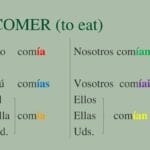This comprehensive guide will equip you with everything you need to know about conjugating the Spanish verb preparar (to prepare). Whether you’re a beginner just starting your Spanish journey or an intermediate learner looking to refine your skills, this guide offers clear explanations, practical examples, and helpful tips to master this essential verb. We’ll explore all the tenses and moods, including indicative, subjunctive, and imperative, ensuring you can confidently use preparar in any context.
Understanding Preparar
Preparar is a regular -ar verb, meaning it follows predictable conjugation patterns. This makes it relatively straightforward to learn compared to irregular verbs. Understanding how to conjugate preparar is crucial for expressing a wide range of actions, from preparing a meal (preparar la comida) to preparing for a trip (prepararse para un viaje).
Conjugation Tables and Examples
Present Indicative
The present indicative tense describes actions happening now. Think of it as the “default” tense.
| Subject Pronoun | Conjugation | Example (Meaning) |
|---|---|---|
| Yo (I) | preparo | Yo preparo la cena. (I prepare dinner.) |
| Tú (You – informal) | preparas | Tú preparas el desayuno. (You prepare breakfast.) |
| Él/Ella/Usted (He/She/You – formal) | prepara | Ella prepara un pastel. (She prepares a cake.) |
| Nosotros/Nosotras (We) | preparamos | Nosotros preparamos la fiesta. (We prepare the party.) |
| Vosotros/Vosotras (You – informal, Spain) | preparáis | Vosotros preparáis la mesa. (You all prepare the table.) |
| Ellos/Ellas/Ustedes (They/You – formal) | preparan | Ellos preparan el informe. (They prepare the report.) |
Preterite Indicative
The preterite tense describes completed actions in the past.
| Subject Pronoun | Conjugation | Example (Meaning) |
|---|---|---|
| Yo (I) | preparé | Ayer preparé una presentación. (Yesterday I prepared a presentation.) |
| Tú (You – informal) | preparaste | Tú preparaste una sorpresa. (You prepared a surprise.) |
| Él/Ella/Usted (He/She/You – formal) | preparó | Él preparó el café. (He prepared the coffee.) |
| Nosotros/Nosotras (We) | preparamos | Nosotros preparamos la excursión. (We prepared the trip.) |
| Vosotros/Vosotras (You – informal, Spain) | preparasteis | Vosotros preparasteis el examen. (You all prepared the exam.) |
| Ellos/Ellas/Ustedes (They/You – formal) | prepararon | Ellas prepararon la casa. (They prepared the house.) |
(Continue this structure for all tenses and moods, including Imperfect Indicative, Future Indicative, Conditional Indicative, Present Perfect Indicative, Past Perfect Indicative, Future Perfect Indicative, Conditional Perfect Indicative, Present Subjunctive, Imperfect Subjunctive [both forms], Future Subjunctive, Present Perfect Subjunctive, Past Perfect Subjunctive [both forms], Future Perfect Subjunctive, and Imperative [affirmative and negative]. Provide clear tables and example sentences for each.)
Regular -AR Verb Conjugation
As mentioned earlier, preparar is a regular -ar verb. This means it follows the standard conjugation pattern for -ar verbs. The stem (prepar-) remains the same, and the endings change based on the tense and subject.
Usage Examples in Context
- Preparing Food: Ella prepara un pastel. (She is preparing a cake.) For a delicious Puerto Rican dessert, try the morir sonando recipe.
- Preparing for an Event: Nosotros preparamos la fiesta. (We are preparing the party.)
- Preparing a Document: Ellos preparan el informe. (They are preparing the report.)
Comparing Preparar with Similar Verbs
While preparar generally means “to prepare,” other verbs like hacer (to make/do) and alistar (to get ready) can have overlapping meanings. Hacer is more general, while alistar often implies getting oneself ready. Understanding these nuances can help you choose the most appropriate verb.
Common Mistakes to Avoid
- Preterite vs. Imperfect: The preterite is for completed past actions, while the imperfect describes ongoing or habitual past actions. For example, preparé la cena (I prepared dinner – completed action) versus preparaba la cena cada noche (I used to prepare dinner every night – habitual action).
- Reflexive Pronouns: Remember to use reflexive pronouns (me, te, se, nos, os, se) when the action of preparing is done to oneself (e.g., me preparo para la fiesta – I prepare myself for the party).
Tips for Mastery
- Practice Regularly: Consistent practice is key to internalizing verb conjugations.
- Use Flashcards: Flashcards can help you memorize different forms of preparar.
- Immerse Yourself: Surrounding yourself with Spanish as much as possible will accelerate your learning.
- Find a Language Partner: Practicing with a native speaker provides valuable feedback and improves fluency. To easily remember the spectrum of colors, try the helpful pale gas mnemonic.
By following this guide and incorporating these tips, you’ll be well on your way to mastering the conjugation of preparar and confidently using it in your Spanish conversations. Remember that language learning is a journey, so embrace the process, celebrate your progress, and don’t be afraid to make mistakes along the way.
- Discover Northern Pakistan’s Hidden Gems: Your Ultimate Guide - March 27, 2025
- Explore Eastern Canada: Unforgettable Adventures Await - March 27, 2025
- Unlock New St. John’s Potential: Education & Faith - March 27, 2025
















